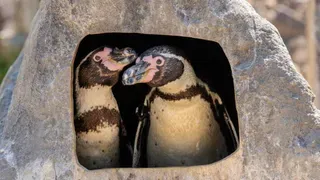November 20, 2015
Manure from Millions of Hogs Fuels Natural Gas Project
Margaret Stafford READ TIME: 3 MIN.
One recipe for renewable natural gas goes: Place manure from about 2 million hogs in lagoons, cover them with an impermeable material and let it bake until gas from the manure rises. Then, use special equipment to clean the gas of its impurities and ship the finished product out.
That's the vision of one of the largest biogas projects of its kind in the U.S. currently being installed in northern Missouri, part of a long-term effort to turn underused agriculture resources into an engine for environmentally friendly farming practices.
The joint project, involving Roeslein Alternative Energy and Smithfield Food Hogs Production, will first convert manure from hogs on nine farms into renewable natural gas, with a goal of selling it as soon as 2016. The second phase would add native prairie grasses planted on erodible or marginal farm land to the manure to increase the biomass.
Developers expect the first phase to produce about 2.2 billion cubic feet of pipeline-quality natural gas, providing an alternative energy source while also keeping an estimated 850,000 tons of methane, a major greenhouse gas, from escaping into the atmosphere. Plus, the covers mostly eliminate the odor that can permeate the area around large hog farms, reduce the amount of waste-tainted water that leeches into the ground and capture thousands of gallons of clean water for re-use.
"We have the science to make farming work better for the environment. The question is do we have the political will, and the financial will, to do it," said RAE founder Rudi Roeslein, who has invested $25 million in the project.
A 2014 federal report showed 239 manure-based digesters were operating in the U.S. And the federal Department of Agriculture issued $6 million in grants last month for anaerobic digester projects, as part of the Rural Energy for America Project, an Obama administration effort to spark projects that generate alternative energy and reduce carbon emissions.
But Roeslein, the co-founder of St. Louis-based Roeslein and Associates, which designs and builds manufacturing systems, is not seeking government funding because he does not want to be dependent on federal bureaucracy as the project develops.
The first phase, with an estimated price tag of $120 million, began in 2013, when RAE and Smithfield agreed to place impermeable covers over 88 manure lagoons. That turns the lagoons into anaerobic digesters, which decompose the manure and force biogas to the top. Special machines will then collect and clean the biogas, leaving more than 98 percent methane with nearly the same chemical composition as natural gas, which will be sent into the national natural gas pipeline.
About half of the lagoons are already covered and equipment based on technology used in Europe will be installed next summer at a farm near Albany, Missouri, Roeslein said during a recent presentation on the farm. Duke Energy in North Carolina has agreed to buy about one-third of the finished product, due to be delivered next summer.
The project will mostly eliminate problems associated with manure lagoons, such as rainfall runoff and methane escape, which will save Smithfield hundreds of thousands of dollars, according to Blake Boxley, the hog division's director of environmental health and safety.
"We saw a chance to reduce our company's carbon footprint while also showing that farmers can protect land and water while they are producing our food," he said.
The project is unusual because most biogas projects involve industrialized facilities, said Zhiqiang Hu, a professor of civil engineering at the University of Missouri. Anaerobic digestion systems are widespread in Europe, but U.S. farmers have hesitated to adopt the practice in part because the technology requires a lot of land, he said.
"Our farmers tend to use simpler means of handling waste," he said. "But for larger facilities, this production practice could definitely be helpful."






